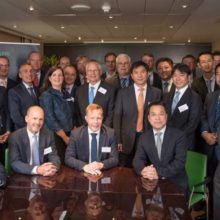Over 90% of global trade moves by sea and this trade is expected to increase substantially over the coming years. In terms of tonne miles, shipping is the world’s cleanest form of transport, but the volumes moved are so large that shipping is a significant contributor to global greenhouse gas, sulphur oxides and nitrogen oxides emissions.
The emissions reduction requirements that have come into force around the world to respond to this challenge are increasing demand for LNG as a shipping fuel. LNG offers notable environmental advantages over heavy fuel oil, the main fuel used in shipping today, significantly reducing sulphur oxides and nitrogen oxides and particulate emissions, and also contributing to the reduction of greenhouse gas emissions. LNG is therefore able to offer a fuel solution compliant with both current and anticipated future regulations.
However, while LNG is a competitive fuel relative to current alternatives, LNG infrastructure is needed in ports around the world to enable quick, safe and cost effective bunkering. In parallel, there remains a price premium for LNG-fuelled vessels which can make investment decisions challenging. Furthermore, regulation is not yet globally consistent, which constrains incentives for investment in the sector. SEA\LNG aims to address and help overcome these and other challenges.
Philip Olivier, CEO of ENGIE Global LNG, commented: “Everybody is calling for alternatives to reduce environmental impacts. That’s why we have joined forces to actively promote LNG as a key fuel in maritime transport. LNG has the potential to take a 10% market share of global bunker demand by 2030. ENGIE will contribute to achieving this target”.
Tom Strang, Senior Vice President, Maritime Affairs, Carnival Corporation & plc, said: “By working together proactively across the whole marine LNG value chain we can make the transition to a lower emission marine sector a reality. We are proud to share this aim and to align ourselves with other innovators in this field”.
Lauran Wetemans, Shell’s General Manager Downstream LNG, said: “This new cross-industry initiative is good news. To make the transition to LNG as a fuel happen it needs close collaboration with key players across the full value chain. SEA/LNG aims to promote the benefits and potential of LNG fuel, and create a level playing field for LNG with other fuels. It will complement the work being done by other organisations like the Society for Gas as a Marine Fuel.”
Tjerk-Johan de Vries, Region Manager West Europe & Africa at DNV GL, said: “The groundwork has been laid for LNG to thrive, but we need a cross-industry approach to realize the full potential of LNG fuelled shipping. Having been at the forefront of LNG fuelled shipping since its beginning, DNV GL is proud to work with innovative partners to help LNG take its place as a key fuel for the future.”
And Leo Karistios, Gas Technology Lead, Lloyd’s Register, said: “LNG fuelled shipping has mainly been for the visionaries and, until now, concentrated in specialist ship sectors – short sea shipping and ferries, mainly sailing between two fixed ports. We want to help drive the expansion of LNG as a marine fuel of choice, with not just more short sea and local ships burning gas, but also the deep sea trades.”


